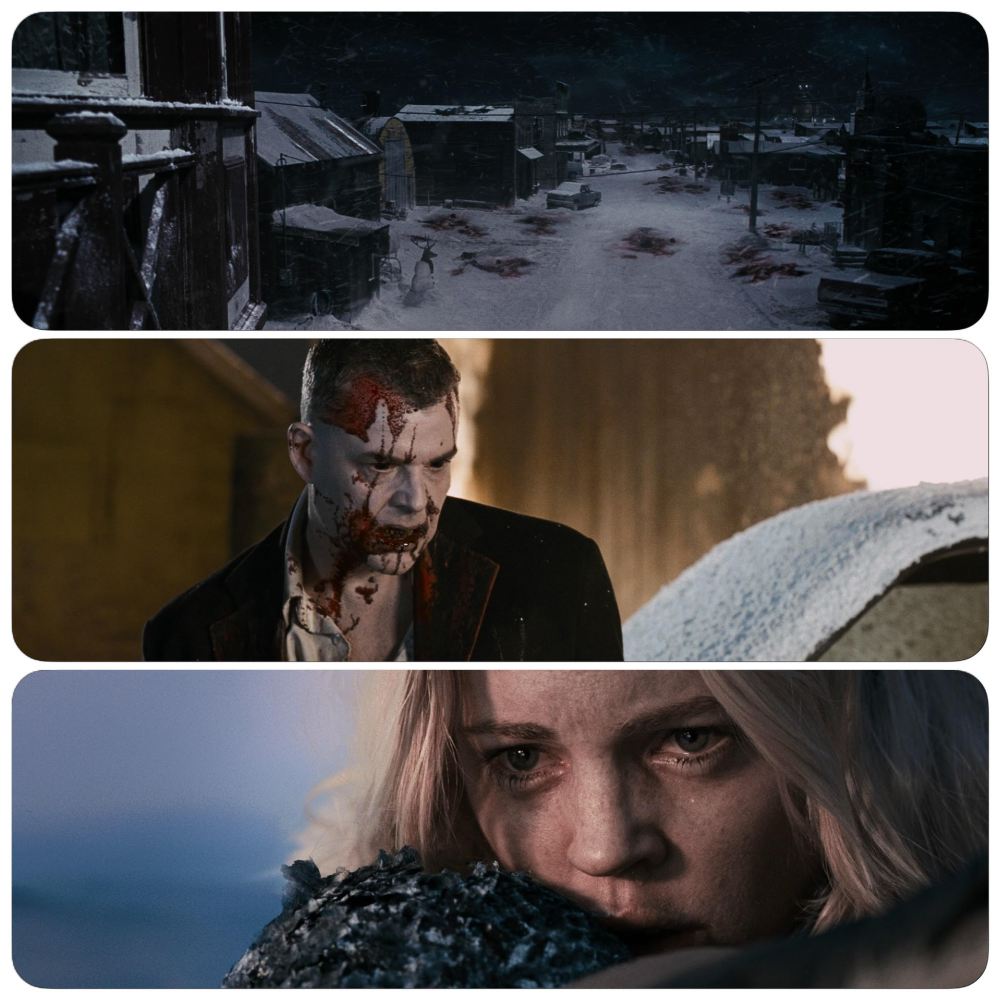Horror movies in general, and monster movies in particular, work because they all abide by certain sets of rules that help us relate to forces we otherwise could not comprehend. Sometimes, these strictures are also our way of finding some method for defeating our nemeses…or at least exploit them long enough to escape. Thus, zombies shuffle, werewolves only hunt at full moon, and vampires cannot enter a house unless asked. But as these archaic concepts become worn-out with so many re-tellings, writers employ novel ways to bend and break these rules to tell different kinds of stories with zombies that run faster than people, werewolves who can transform at will, vampires who don’t have to fear the break of day…and movies like 30 Days of Night.
The story takes place in the Arctic town of Barrow, Alaska, which is about to batten down the hatches for its annual polar nightfall, when the down goes dark for a whole month. As the townspeople make preparations, a mysterious stranger sabotages Barrow’s communications and transportation links to the outside world, and is soon imprisoned by the local sheriff, Eben Oleson. Eben, his estranged wife Stella, and a circle of friends and colleagues hardly have time to figure out what this stranger’s deal is before night falls and a pack of vampires openly assaults the town, slaughtering the people of Barrow without restraint and staining the hard-packed snow streets with blood. After the initial feeding frenzy, the remaining survivors play a tense game of cat and mouse as they try to stay one step ahead of the predators who now rule their home, wondering what it will take for them to survive until daylight. The answer to that question, it turns out, is something few of them will want to hear, let alone act upon. In a town where there is no longer any sunlight, darkness can take different forms.
This is not a perfect movie. In fact, plenty of viewers would pan it for its uneven pacing (entire weeks go by between the story’s acts), its various plot holes, and its decision to focus on over-the-top gore than on genuine scares or an even deeper sense of horror. 30 Days of Night, in many ways, feels more like an action survival story than a horror tale, populated as it is by vampires who exhibit few of the powers and weaknesses of myth, and are instead a simplified menace: a humanoid apex predator that is cruel, yes, but seems to have as little regard for morality as does a shark when it bites a seal in half. Everybody’s gotta eat, right?
The vampires themselves are what carry the movie, really, for we can imagine what kind of secret, dangerous and vulnerable lives they must live when dwelling in the shadows of human cities, looking for opportunities to hunt without risk of detection. These vampires look so inhuman, and act in such a bestial nature, we don’t imagine them beguiling unwitting victims to their doom. We imagine them snatching people from beneath street lamps, and breaking into homes in a savage frenzy, but only enough to keep from starving. Starvation is the predator’s lot, regardless of species, and once these vampires make it to Barrow, they finally can feed as they like, run in packs, and let their victims blood dry on their skin. We don’t sympathize with the vampires of Barrow, but we can appreciate why it is they decided to invade this lonely town on the edge of the world. It kind of makes you wonder why a race of creatures known for living so long didn’t think of it any sooner, especially during one of the movie’s most effective shots—a long overhead look at the vampires slaughtering people in the snow. It reminds us that monster movies are really stories about predators who would be doing a lot more killing if only they could just rid of their shackles. There’s nothing quite as unsettling as seeing humans turned into slaughter stock for something else’s appetite.
Once the vampires hit Barrow, the remainder of the movie is a by-the-numbers battle for survival as some folks make bad decisions and end up as vampire chow, others take a heroic way out and prove that humans are the kind of prey species that can kill you if you’re not careful, and still others try to figure out how to escape Barrow and warn the rest of the world. As the days of the month drag on, so does the movie, until we finally get down to just Eben and Stella and a handful of others. As the last act plays out, and we see what exactly it will take for these folks to walk out of Barrow alive, we see that this movie ultimately is less about Eben than it is about Stella. Had 30 Days of Night been more successful and spawned a long-running franchise like the comic book that preceded it, we might have gotten to see that this movie is really meant to be a great, big prologue, and a kind of origin for Stella Oleson, vampire hunter. Pity we never got that, because what little we see of Stella in 30 Days of Night, and especially in its final shot, offer a compelling glimpse into the birth of a compelling new hero we’ll sadly never get to see.
As least we get her in the movie’s moment of truth, when she looks upon her next sunrise a much-changed woman, knowing that humanity can be noble as Barrow’s fallen defenders, or as savage as the monsters that devoured her fellow townsfolk. Vampires never get to make that choice, and wouldn’t want it even if they could. But humans do, and most of them never make the right one. The few who do are the ones worth holding on to. Even if there is nothing left to hold but ash.






